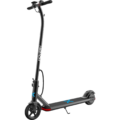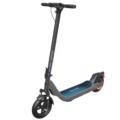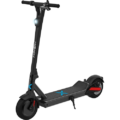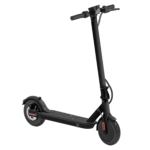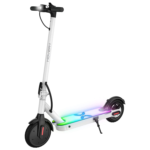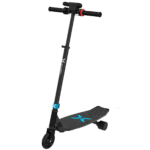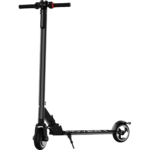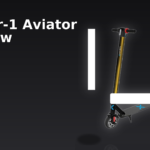- Home
- Scooters
- Electric Scooters
- Hover-1 Flare
Hover-1 Flare
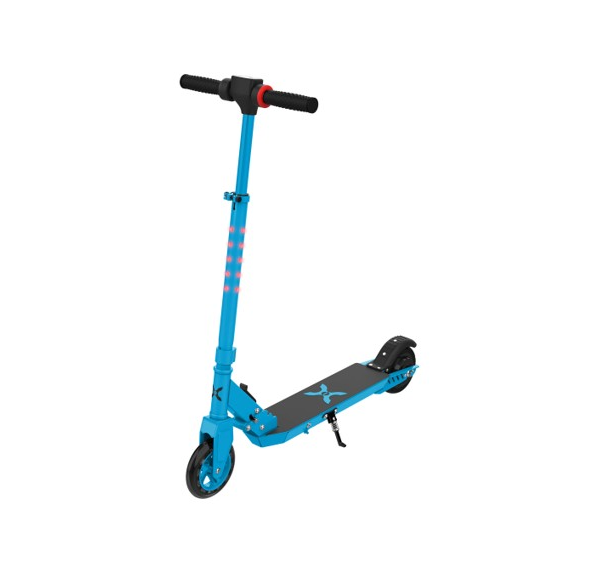

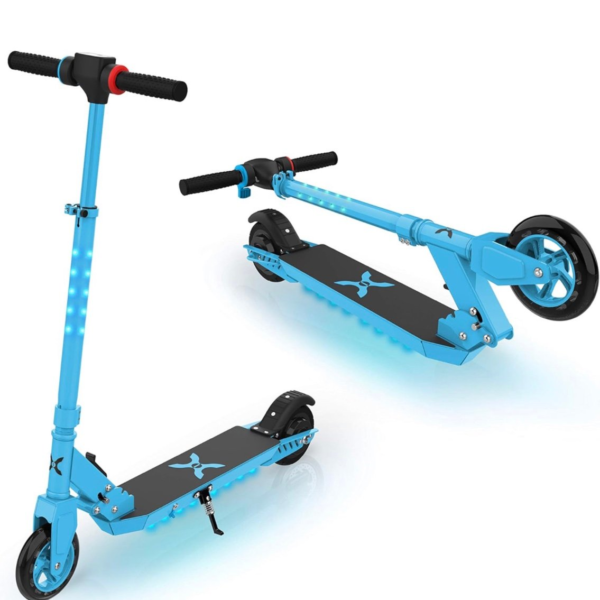
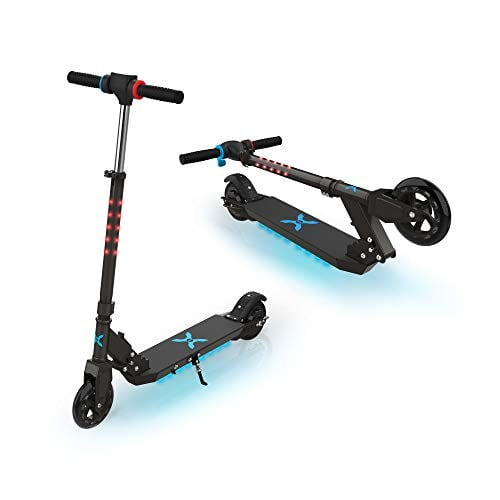
- Battery Range: 3 miles (5 km)
- Top Speed: 8 mph (13 km/h)
- Motor Power: 120 W
- Weight Capacity: 132 lb (60 kg)
- Charging Time: ~6 h
- Scooter Weight: Not specified
PROS
- Kid-friendly 8 mph top speed
- Up to 3-mile play range
- Cruise control available
- Solid tires (6.5″ front / 5.5″ rear)
CONS
- Very short range
- No suspension
- Low max rider weight (132 lb)

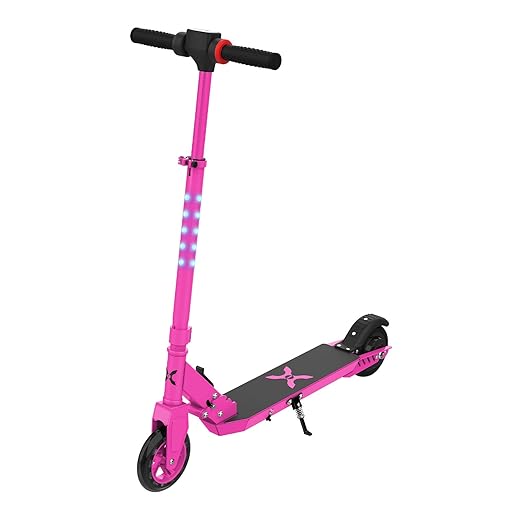
Table of contents
- What Is the Hover-1 Flare?
- How the Hover-1 Flare Works
- Key Specifications (clean table)
- Design & Build Quality
- Performance Fundamentals
- Battery, Range & Efficiency
- Ride Quality & Comfort
- Braking & Safety Features
- Portability & Daily Usability
- Maintenance & Care
- Weather & Seasonal Considerations
- Hover-1 Flare vs Alternatives
- Who the Hover-1 Flare Is (and Isn’t) For
- FAQs
- Glossary
- Final Thoughts
The Hover-1 Flare is a compact, UL-listed* kids e-scooter made for short neighborhood rides, school runs, and smooth paths. It pairs a 120W rear hub motor with a 36V battery, simple controls, and playful LED lighting. Because it’s light and easy to fold, it suits young riders and smaller beginners who want safe, predictable speeds without the upkeep of bigger commuter scooters.
Moreover, if you want a straightforward ride that emphasizes stability, light weight, and low maintenance, the Hover-1 Flare fits the brief. However, it is tuned for short distances and light loads, so it isn’t intended for long commutes or steep hills.
What Is the Hover-1 Flare?
At its core, the Hover-1 Flare is a foldable, entry-level electric scooter designed primarily for kids and smaller teens. It favors easy handling and predictable behavior over raw speed. With up to 8 mph (12.8 km/h) top speed and up to 3 miles (4.8 km) of rated range, it serves as a short-hop machine you can fold and store in seconds.
Furthermore, the scooter weighs 22 lb (10 kg), which makes carrying it up stairs or into a trunk manageable for most adults. The frame is compact, the deck is low, and the handlebar height is adjustable. Because the tires are solid (non-pneumatic)—6″ front and 5.5″ rear—you avoid flats and pump checks. You also get blended braking: a left electronic brake for gentle slowing and a rear mechanical foot brake to finish stops. Additionally, the stem and deck LEDs add visibility and flair, which kids appreciate.
“UL-listed” refers to the product’s electrical safety listing. Always check your unit’s label.
How the Hover-1 Flare Works
Motor and Controller. The Flare uses a 120W brushless hub motor in the rear wheel. The controller meters battery power to the motor based on throttle input. Consequently, acceleration is smooth and steady rather than punchy, which builds confidence for new riders.
Battery. Power comes from a 36V, 2.0Ah lithium-ion pack (about 72 Wh). In car terms, the battery is the fuel tank, and the controller is the injector. Because power and gearing are modest, the Flare focuses on quiet cruising and predictable behavior.
Throttle. The right-hand electronic throttle behaves with gentle response. Press to go; release to coast. For comfort, a quick double-press engages cruise control at your current speed. Press again or pull a brake to exit.
Brakes. Two systems work together. The left lever activates electronic braking, which adds motor drag and slows the scooter smoothly. Meanwhile, the rear mechanical foot brake increases stopping power at very low speeds. Used together, they provide confident stops for a lightweight scooter.
Finally, the Flare is kick-to-start, which helps prevent accidental launches. You push off first, then apply throttle. As a result, balance comes first and power comes second, which is ideal for beginners.
Key Specifications (clean table)
The table below summarizes the official specifications in both imperial and metric units.
General
| Item | Spec |
|---|---|
| Model | H1-FLRE |
| Intended use | Short, low-speed neighborhood rides |
| Net weight | 22 lb (10 kg) |
| Rider weight (min–max) | 44–132 lb (20–60 kg) |
| Frame finish | Compact folding frame with LED stem/deck |
| Display | Simple LCD (speed + battery) |
Performance & Power
| Item | Spec |
|---|---|
| Motor | 120W brushless rear hub |
| Top speed | Up to 8 mph (12.8 km/h) |
| Hill ability | Best on gentle grades (≈ 5°); kick-assist recommended |
| Drive | Rear-wheel hub motor |
Battery, Charging & Electrical
| Item | Spec |
|---|---|
| Battery | 36V, 2.0Ah Li-ion (~72 Wh) |
| Charger input | AC 100–240V, 50/60Hz |
| Typical charge time | Up to ~4 hours |
| Lights | LED accents on stem and under-deck; LCD backlight |
| Cruise control | Yes (quick double-press to set) |
Build & Dimensions
| Item | Spec |
|---|---|
| Tires | Solid (non-pneumatic) |
| Tire sizes | Front 6″ (15.24 cm), Rear 5.5″ (13.97 cm) |
| Unfolded size (H × W × D) | 37.4 × 33.8 × 14.96 in (95 × 86 × 38 cm) |
| Folded size (H × W × D) | 10.6 × 31.4 × 14.9 in (27 × 80 × 38 cm) |
| Handlebar | Height-adjustable |
| Kickstand | Yes |
Safety & Control
| Item | Spec |
|---|---|
| Brakes | Electronic front (lever) + mechanical rear (foot) |
| Start behavior | Kick-to-start |
| Water resistance | Water-resistant design; avoid heavy rain and puddles |
| Reflectors | Not equipped; use bright clothing and extra lights as needed |
Features & Extras
| Item | Spec |
|---|---|
| Cruise Control | Yes (double-press to set, press again to cancel) |
| LEDs | Stem LEDs and under-deck LEDs |
| Display data | Speed (mph) and battery level |
| Fold mechanism | Quick lever fold; compact footprint |
Warranty & Compliance
| Item | Spec |
|---|---|
| Warranty | 90-day limited (manufacturer defects) |
| Compliance | UL electrical safety listing (check device label) |
Design & Build Quality
From the first glance, the Flare’s layout prioritizes simplicity and robustness. The deck is low and flat, which helps beginners step on confidently. The folding lever sits near the front of the deck; it’s chunky and easy to operate, even for small hands with parent supervision. Because the stem is slim yet adequately stiff for this speed class, steering feels direct without twitchiness.
Fit-and-finish is straightforward. You’ll see exposed fasteners, LED portholes on the stem, and under-deck lighting. While those LEDs are more about being seen than lighting the road, they improve visibility at dusk and add a bit of fun. Since the tires are solid, the scooter’s sealed wheel design resists punctures and routine debris. In addition, the rear fender doubles as a mechanical brake, which keeps the parts list simple and rugged.
The LCD is basic and legible in daylight. Under strong sun it can wash out slightly; however, the battery icon and speed remain readable. Overall, build quality feels sturdy for the weight, and the hinge locks securely when fully engaged. If a rider taps curbs at walking pace, the solid tires and plastic deck skins handle light scuffs better than thin rubber. Even so, avoid hard impacts, because the lightweight fork is not engineered for stunt landings.
Performance Fundamentals
At up to 8 mph (12.8 km/h), this scooter runs at a brisk jogging pace. Starts are gentle. With kick-to-start, you push off and then add throttle. Consequently, acceleration builds smoothly and tops out without a surge. Most kids and smaller beginners will appreciate that predictable ramp; it encourages balance and reduces surprises near crosswalks.
Cruising stability is solid on clean sidewalks and smooth asphalt. Because the wheelbase is short and the tires are small, the steering remains responsive. That quick feel helps in tight turns on park paths. Nevertheless, keep both hands on the bars and look ahead to maintain a steady line. Above 6–8 mph, the chassis stays calm. You won’t see meaningful stem wobble if you ride with relaxed arms.
Hill behavior depends on rider weight and grade. On gentle slopes (~5°), the Flare climbs if you maintain speed with a kick-assist at the start. On 7–10% grades, momentum drops quickly. In those moments, add a foot push or walk the scooter to preserve the motor and battery. That pattern is normal for a 120W drive system.
Battery, Range & Efficiency
The 36V, 2.0Ah pack stores roughly 72 Wh of energy. That’s enough for up to 3 miles (4.8 km) under ideal conditions: a smaller rider, smooth pavement, mild temperature, steady speed, and few stops. Real life varies; therefore, treat the rating as guidance rather than a promise.
- Rider weight. Heavier riders draw more current to maintain speed. As weight rises, range falls.
- Terrain. Hills and rough paths sap energy. Flat, clean pavement maximizes distance.
- Temperature. Lithium-ion chemistry prefers moderate temperatures. Cold reduces capacity, while extreme heat accelerates aging.
- Speed and stops. Frequent stop-and-go riding wastes energy. Consequently, cruise control at a steady pace helps.
- Tire type. Solid tires avoid flats, yet they add a touch of rolling resistance. That trade is often worth it for low upkeep.
Charging best practices. Top up after rides, but avoid storing at 100% for weeks. If you pause riding for a month, leave the battery around 50–70% and recharge every 4–6 weeks. Additionally, avoid deep discharges to zero. During charging, place the scooter on a hard, dry surface away from flammables and never cover the charger.
Charge time is about four hours from low to full. Because the pack is small, brief top-ups before a school run are practical. Still, let the charger complete its cycle periodically so the battery management system can balance the cells.
Ride Quality & Comfort
Because the Flare uses solid tires and no suspension, ride feel is firm. On smooth pavement, the scooter rolls quietly with little vibration. On cracks or coarse sidewalks, you’ll feel texture through the deck and grips. That is typical in this class. To stay comfortable:
- Slow slightly on rough patches, especially at seams.
- Unweight your knees when crossing expansion joints.
- Choose smoother lines around potholes and root heaves.
The low deck helps stability and reduces leg fatigue because your stance stays neutral. Stem flex is modest at this speed, and the handlebar height adjustment allows a comfortable reach for different riders. If multiple children share the scooter, set the bar just below shoulder height of the rider’s standing posture. As a result, control improves immediately and fatigue drops.
Braking & Safety Features
The two-part braking system suits beginners:
- Electronic brake (left lever): It creates motor drag for smooth deceleration. Use it to trim speed well before a turn.
- Mechanical brake (rear foot): It adds bite at very low speeds and during final stops. Apply with steady pressure; stamping can skid the rear wheel.
Because the scooter is light, stopping distances at 8 mph are short when riders use both brakes properly. Therefore, practice in a safe area. Start with electronic braking, then add a gentle foot press to finish the stop.
Lighting focuses on being seen rather than lighting the road. Stem LEDs and under-deck light strips increase visibility at dusk. Since the Flare does not include reflectors, equip riders with bright or reflective clothing and consider an add-on front light if riding near sunset.
Regarding water exposure, the Flare is water-resistant, not waterproof. Avoid standing water and heavy rain. After damp rides, dry the scooter and store it indoors.
Portability & Daily Usability
At 22 lb (10 kg), the Flare is manageable for adults to carry one-handed for short distances. The folding lever works quickly, and the folded footprint—10.6 × 31.4 × 14.9 in ( 27 × 80 × 38 cm )—fits car trunks, classroom corners, and closet floors. Additionally, the 33.8 in (86 cm) bar width is broad for a kids scooter, which improves control; just be mindful at narrow doorways.
For multi-modal days with school drop-offs or park trips, the Flare’s compactness is a real advantage. Because the kick-start requires a push to engage, accidental throttle bumps while walking are less likely to move the scooter. As a result, sidewalk handling feels safer.
Security remains simple: bring the scooter indoors. If you must leave it briefly, use a small cable lock through the deck opening or around the folded stem; however, supervised parking is the safer choice.
Maintenance & Care
The Flare is low-maintenance by design. Even so, a simple cadence keeps it running well.
Before every ride (30 seconds).
- Check the fold latch is fully locked.
- Squeeze the electronic brake and test the rear foot brake.
- Scan the tires for debris lodged in the tread.
- Verify battery level on the LCD.
Weekly (5 minutes).
- Inspect all fasteners (hinge bolts, handlebar screws). Snug with the supplied hex key if anything loosens.
- Wipe the deck and stem LEDs with a dry cloth. Avoid solvents and high-pressure water.
- Confirm the kickstand swings freely.
Monthly (10 minutes).
- Look for cable wear near the handlebar controls.
- Review the charger and port; ensure pins are straight and clean.
- Cycle the battery between 30–90% occasionally to keep the gauge honest.
Seasonal storage.
- Store at 50–70% charge.
- Keep it indoors in a dry, ventilated space.
- Top up every 4–6 weeks if unused.
Because the tires are solid, you won’t inflate them, patch tubes, or chase slow leaks. Consequently, most routine time goes to quick checks rather than repairs.
Weather & Seasonal Considerations
Rain. Light splashes are tolerable, but avoid heavy rain and puddles. Wet surfaces reduce traction, especially with small, solid tires. Therefore, brake earlier and ride gently.
Cold. Below about 40°F (4°C), battery output and lubrication suffer. Range drops, acceleration softens, and plastic trim becomes brittle. Accordingly, warm the scooter indoors before charging.
Heat. Prolonged exposure to direct sun can heat-soak the deck and battery. After a hot day, let the scooter cool to room temperature before charging. Additionally, avoid leaving the scooter in a parked car.
Dusk and night. The Flare’s LEDs help visibility, yet they don’t replace a road-aimed headlight. If riding near dusk, add a clip-on front light and wear reflective gear. Since the scooter lacks reflectors, visibility gear matters more than usual.
Hover-1 Flare vs Alternatives
In the scooter world, classes differ by motor power, wheel size, and overall intent:
- Kids/Beginner Class (like Flare). Advantages: light, easy, low maintenance, friendly speeds. Perfect for first-time riders and short rides. Trade-offs: limited range and hill performance, firmer ride on rough surfaces.
- Commuter Class (300–500W, 9–10″ tires). These add speed, range, and comfort. However, they weigh more, cost more, and require tire care if pneumatic.
- Performance Class (700W+). Built for long distances and higher speeds. They demand experience, more maintenance, and larger storage space.
- Off-Road/Trail Class (wide knobbies, suspension). Great for dirt paths and parks, but heavy and overbuilt for sidewalks.
When the Flare excels: short school runs, smooth neighborhood loops, and early throttle practice. Its solid tires and simple brakes reduce upkeep and confusion. Conversely, if you need longer range, steeper hills, or bigger wheels for rough pavement, a commuter model becomes the better fit.
Who the Hover-1 Flare Is (and Isn’t) For
Ideal for:
- Kids and smaller teens within the 44–132 lb (20–60 kg) range.
- First-time riders who want steady top speed and confidence-building controls.
- Short trips on smooth surfaces where portability matters.
- Families that value low maintenance and kick-start safety.
Not ideal for:
- Riders seeking long commutes, faster speeds, or steep hill climbing.
- Adults above the weight rating.
- Broken pavement where larger pneumatic tires and suspension are essential.
Ultimately, choose the Flare if simple controls, light weight, and minimal upkeep are top priorities. Otherwise, step up to a commuter scooter for more speed and comfort.
For very young riders who need an even simpler first step, consider the Hover-1 My First E-Scooter as a lower-speed, early-learner option.
FAQs
1) How fast does the Hover-1 Flare go?
It reaches up to 8 mph (12.8 km/h) under ideal conditions. Because power is modest, that speed feels steady rather than intense.
2) What is the real-world range?
Expect up to 3 miles (4.8 km) in ideal weather on smooth pavement with a smaller rider. Stops, hills, and cold weather reduce distance, as they do on any e-scooter.
3) Does it have cruise control?
Yes. Double-press the throttle quickly to set cruise at your current speed. Press again or use a brake to exit.
4) Is it water resistant?
The Flare is water-resistant, but not waterproof. Avoid heavy rain and puddles. Dry the scooter after damp rides and store it indoors.
5) What does the warranty cover?
There’s a 90-day limited warranty for manufacturer defects. Keep proof of purchase and the unit’s serial label.
6) Can adults ride it?
Only if they fall within 132 lb (60 kg) and accept the scooter’s low speed and short range. It’s designed for kids and beginners rather than adults.
7) Where can I find a quick Hover-1 Flare overview?
You’re reading one now. This Hover-1 Flare overview explains what it is, how it works, and who it’s for.
Glossary
- Ah (Amp-hour): Battery capacity measure. The Flare’s pack is 2.0Ah at 36V.
- Wh (Watt-hour): Energy measure (V × Ah). The Flare stores ~72 Wh.
- Brushless hub motor: Electric motor built into the wheel; efficient and quiet.
- Controller: Electronic “brain” that meters battery power to the motor.
- Kick-to-start: Requires a foot push to begin; prevents accidental launches.
- Regen/electronic braking: Motor-based slowing that adds electrical drag.
- Mechanical foot brake: Rear fender brake that uses friction to stop.
- Stem flex: Side-to-side or fore-aft movement of the handlebar mast under load.
- IP rating: Ingress protection score for dust/water. The Flare is water-resistant, with no specific rating published.
- UL listing: Independent electrical safety certification; check your unit’s label.
- Solid tire: Non-pneumatic tire that can’t go flat; rides firmer than air-filled tires.
- Cruise control: Maintains current speed automatically until canceled.
- BMS (Battery Management System): Protects the battery and balances cells.
- Hill grade/percent: Slope steepness; small motors handle only modest grades.
- Roll-to-coast: Releasing the throttle lets the scooter coast without braking.
Final Thoughts
The Hover-1 Flare focuses on safe learning, short trips, and low-stress ownership. It’s light, easy to fold, and simple to ride. The 120W motor and solid tires keep upkeep minimal, and cruise control helps riders hold a steady pace. In return, you accept limited range, modest hill ability, and a firmer ride on rough concrete. Even so, if that trade-off matches your needs, the Flare is a sensible starter scooter.
Specifications
General
| Model The Model specifies the exact version or name of the scooter. It helps identify its unique design, features, and specifications within the manufacturer’s product line. Knowing the model makes it easier to compare options, find compatible accessories, or look up support information. | Flare |
| Brand The Brand identifies the manufacturer or company that designs and produces the scooter. A trusted brand is a sign of quality, reliability, and good customer support. Well-known brands often have higher standards for safety, performance, and after-sales service, giving you more confidence in your purchase. | Hover-1 |
| Release Date The Release Date indicates when the scooter model was officially launched on the market. This helps you know how current the design, technology, and features are. A newer release date often means updated components, improved performance, and the latest safety or smart features. | 17 November 2025 |
| Recommended Age Recommended Age indicates the minimum age range that the scooter is designed for, based on safety, size, and ease of use. Following the recommended age helps ensure that riders can handle the scooter’s speed, weight, and controls comfortably and safely. Always check local laws and use protective gear, especially for younger riders. | +16 |
Performance & Power
| Motor Power (Wattage) What it means: The motor power, measured in watts (W), shows how strong the scooter’s electric motor is. Why it matters: Higher wattage usually means better acceleration, more torque, and improved performance on hills or rough terrain. For example, a 250W motor is good for flat city roads and light riders, while a 500W or 1000W motor provides more power for faster speeds or climbing steep inclines. | 120 W motor |
| Top Speed The Top Speed indicates the maximum speed that the scooter can reach under optimal conditions. It’s usually measured on level ground with a fully charged battery and an average rider weight. A higher top speed allows you to travel longer distances faster, but always ensure you ride within legal speed limits and your personal comfort zone for safety. | Up to 8 mph (13 km/h) |
| Battery Capacity Battery Capacity refers to the total amount of energy the scooter’s battery can store, usually measured in ampere-hours (Ah) or watt-hours (Wh). A higher battery capacity means you can ride longer distances on a single charge, reducing the need for frequent recharging. Keep in mind that actual range can vary depending on rider weight, terrain, speed, and weather conditions. | Not specified |
| Estimated Range per Charge The Estimated Range per Charge indicates the average distance the scooter can travel on a single full battery charge. This range is calculated under optimal conditions, such as flat terrain, moderate speed, and average rider weight. Real-world range may vary depending on riding style, terrain, weather, and load. A longer range means fewer recharges and greater freedom for longer trips. | Up to 3 miles (5 km) |
| Hill Climb Ability Hill Climb Ability describes the maximum incline or slope that the scooter can handle while maintaining stable performance. It’s typically expressed as a percentage or in degrees. A higher hill climb rating means the scooter can tackle steeper hills without losing too much speed or power. Actual climbing performance may vary based on rider weight, battery charge, and terrain conditions. | Not specified |
| Drive System The Drive System refers to how power from the motor is delivered to the wheels. Electric scooters typically use either a hub motor (directly integrated into the wheel) or a chain/belt drive system. A high-quality drive system ensures smooth acceleration, efficient power transfer, and low maintenance. The choice of drive system affects performance, noise level, and overall ride experience. | Not specified |
Charging & Electrical
| Charging Time Charging Time indicates how long it takes to fully recharge the scooter’s battery from empty to 100% using the standard charger provided. Faster charging means less downtime and more time on the road. Actual charging time may vary slightly depending on battery capacity, charger output, and environmental conditions. | Approx. 6 hours |
| Battery Type Battery Type refers to the specific technology used in the scooter’s battery, which affects performance, lifespan, weight, and charging time. Most modern electric scooters use high-quality lithium-ion (Li-ion) batteries because they offer a good balance of energy density, durability, and low maintenance. A reliable battery type ensures consistent power delivery and longer riding ranges. | Not specified |
| Removable Battery A Removable Battery means the battery pack can be easily detached from the scooter for convenient charging and replacement. This feature allows you to charge the battery separately, swap it with a spare for extended range, or securely store it indoors in extreme weather. Removable batteries add flexibility and make it easier to keep your scooter powered up wherever you are. | Non-removable internal battery |
| Regenerative Braking Regenerative Braking is an energy-saving feature that converts some of the energy normally lost during braking back into battery power. When you slow down or brake, the motor works in reverse to generate electricity, which helps extend the scooter’s range and improves overall efficiency. This system also reduces wear on traditional brake components, leading to lower maintenance over time. | No |
| Lighting Lighting refers to the built-in front and rear lights that enhance visibility and safety when riding in low-light conditions or at night. Good lighting helps you see the road ahead and ensures that other road users can see you. Many scooters include LED headlights, taillights, and sometimes brake lights or side reflectors for added safety and compliance with local traffic regulations. | LED lighting on scooter (varies by version) |
Build & Dimensions
| Scooter Weight Scooter Weight refers to the total weight of the scooter when fully assembled, including the battery. This affects how easy it is to carry, lift, and store the scooter when not in use. A lighter scooter is more portable and convenient for commuting, especially if you need to carry it upstairs or onto public transport. Keep in mind that a sturdy frame and quality components may add to the weight but also contribute to better durability and ride stability. | Not specified |
| Maximum Rider Weight Maximum Rider Weight indicates the highest rider weight that the scooter is designed to safely support while maintaining optimal performance and stability. Staying within this limit helps ensure reliable acceleration, braking, and climbing ability, and it protects the frame, suspension, and motor from excessive strain. Exceeding the recommended limit may reduce performance and increase wear on components. | 132 lb (60 kg) |
| Deck Size Deck Size refers to the dimensions of the scooter’s standing platform. A wider and longer deck provides more foot space, allowing you to stand comfortably and adjust your stance while riding. A well-sized deck improves balance and stability, especially on longer rides or at higher speeds. Compact decks, on the other hand, help keep the scooter lightweight and portable. | Not specified |
| Handlebar Height Handlebar Height refers to the distance from the deck to the handlebars, which affects your riding posture and comfort. An appropriate handlebar height helps you maintain good balance, reduces strain on your back and arms, and makes steering more comfortable. Some scooters have adjustable handlebars to fit riders of different heights, while others have a fixed height for a streamlined design. | Fixed |
| Folding Mechanism The Folding Mechanism describes how easily and securely the scooter can be folded for carrying and storage. A well-designed folding system lets you quickly collapse the scooter into a compact size, making it convenient to transport on public transit, store under a desk, or fit into a car trunk. Look for sturdy latches and safety locks to ensure the scooter stays firmly in place when folded or unfolded. | Folding latch |
| Dimensions Folded Dimensions indicate the size of the scooter when it’s fully folded. This measurement shows how much space the scooter will take up when stored or carried, making it easier to check if it will fit in your car trunk, under a desk, or in a closet. Compact folded dimensions are ideal for commuters who need to bring their scooter on public transport or store it in tight spaces. | Not specified |
| Material Material refers to the primary construction materials used for the scooter’s frame and key components. High-quality materials like aircraft-grade aluminum, reinforced steel, or durable composites provide strength, stability, and a lighter overall weight. A sturdy material ensures the scooter can handle daily wear and tear while maintaining safety and performance. | Not specified |
Safety & Control
| Brake Type(s) Brake Type(s) describe the braking systems the scooter uses to help you slow down or stop safely. Common brake types include mechanical brakes (like drum or disc brakes), electronic brakes, and foot brakes. Many scooters combine multiple braking systems for added safety and shorter stopping distances. The type and quality of brakes affect your control, especially when riding at higher speeds or on slopes. | Rear foot brake |
| Suspension Suspension refers to the system that absorbs shocks and vibrations while riding, providing a smoother and more comfortable ride over uneven or rough surfaces. Scooters may have front suspension, rear suspension, or dual suspension for better shock absorption and stability. Good suspension helps reduce rider fatigue and improves control, especially when riding on bumpy roads or off-road paths. | None |
| Tire Type Tire Type refers to the kind of tires the scooter uses, which directly affects ride comfort, traction, and maintenance. Common types include solid (airless) tires, pneumatic (air-filled) tires, or hybrid options. Pneumatic tires offer better shock absorption and a smoother ride on rough surfaces, while solid tires are puncture-proof and require less upkeep. The right tire type helps ensure safe handling and a comfortable ride in different conditions. | Solid tires |
| Tire Size Tire Size indicates the diameter and width of the scooter’s tires, which affect ride comfort, stability, and how well the scooter handles different terrains. Larger tires generally offer better shock absorption and a smoother ride over bumps and rough surfaces, while smaller tires keep the scooter lighter and more portable. Choosing the right tire size helps ensure a balance between agility and comfort. | 6.5-inch front / 5.5-inch rear |
| Kickstand The Kickstand is a built-in stand that allows you to park your scooter upright when it’s not in use. A sturdy kickstand keeps the scooter stable and prevents it from tipping over, protecting it from scratches and damage. It also makes storing and accessing your scooter more convenient, whether you’re at home, work, or on the go. | Not specified |
| Water Resistance Rating Water Resistance Rating indicates how well the scooter is protected against water and moisture, usually shown as an IP (Ingress Protection) rating. This rating helps you understand whether the scooter can handle light rain, splashes, or wet roads without damage. While most scooters are not fully waterproof, a good water resistance rating adds peace of mind when riding in changing weather conditions. Always avoid deep puddles or submerging the scooter to protect its electrical components. | Not specified |
Features & Extras
| Display/Console The Display (or Console) shows important real-time information about your ride, helping you monitor your scooter’s status at a glance. Typical displays show speed, battery level, distance traveled, and riding mode. Some models also include additional features like Bluetooth connectivity, app integration, or backlighting for better visibility at night. A clear and easy-to-read display enhances safety and convenience on every trip. | Basic battery/speed indicator |
| Ride Modes Ride Modes refer to the different speed and power settings you can choose to match your riding style or road conditions. Common modes include eco for maximum range and energy efficiency, standard for everyday balance, and sport or turbo for higher speed and stronger acceleration. Switching between ride modes allows you to customize performance, conserve battery, and ride safely in various environments. | Not specified |
| Smart App Connectivity Smart App Connectivity lets you pair your scooter with a dedicated mobile app via Bluetooth. Using the app, you can monitor real-time ride stats like speed, battery level, and range, adjust settings such as ride modes or cruise control, lock the scooter for added security, and sometimes receive firmware updates. This feature adds convenience and allows you to personalize your riding experience right from your smartphone. | No app |
| Anti-Theft System The Anti-Theft System helps protect your scooter from unauthorized use or theft. This feature can include built-in alarms, electronic motor locks, GPS tracking, or remote locking through a mobile app. A good anti-theft system provides peace of mind when parking your scooter in public spaces, adding an extra layer of security to safeguard your investment. | Not specified |
| Cruise Control Cruise Control allows you to maintain a steady speed without continuously holding the throttle. This feature makes longer rides more comfortable by reducing hand fatigue and providing a smoother, more relaxed riding experience — especially on flat, open roads or bike lanes. For safety, cruise control can usually be easily activated or deactivated while riding. | Yes (cruise control) |
| Accessories Included Accessories Included lists the additional items that come with the scooter to enhance your riding experience and convenience. Common accessories may include a charger, kickstand, bell, lights, phone holder, or carrying strap. These extras add value by making your scooter safer, easier to use, and ready to ride straight out of the box. | Scooter, charger, manual |
Warranty & Compliance
| Warranty Period The Warranty Period indicates how long the manufacturer guarantees the scooter against defects in materials and workmanship under normal use. A good warranty provides peace of mind, showing the brand’s confidence in its product quality. Always check what parts are covered, such as the frame, battery, and motor, and follow the maintenance guidelines to keep your warranty valid. | Region-dependent (kids product warranty) |
| Certifications Certifications confirm that the scooter meets specific safety, quality, and environmental standards set by recognized organizations or regulatory bodies. Common certifications may include CE, RoHS, UL, or other local compliance marks, depending on your region. These certifications ensure that the scooter is manufactured to high standards and is safe and legal to use in your country. | Region-dependent compliance |
Price Comparison




